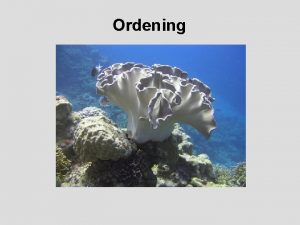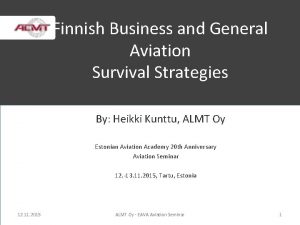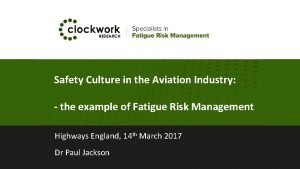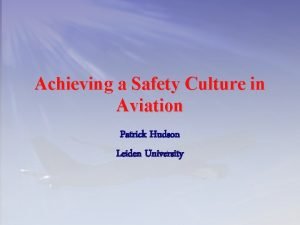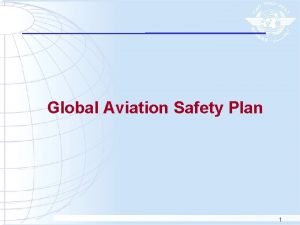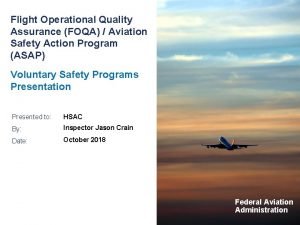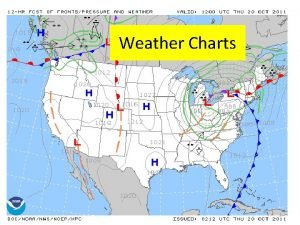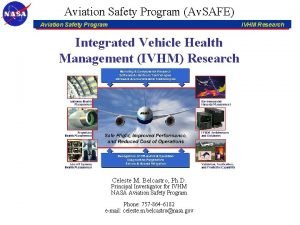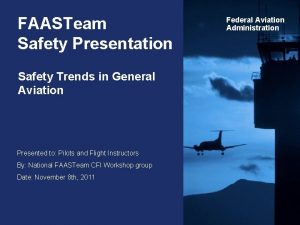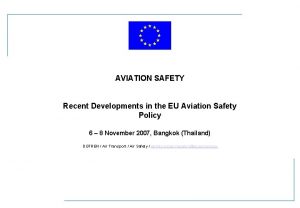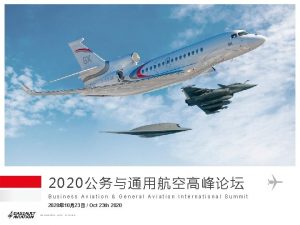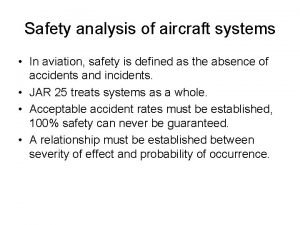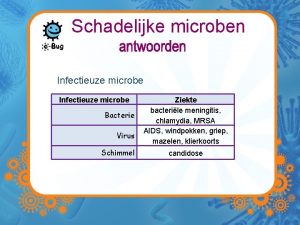SAGA Safety Analysis in General Aviation Josh Schimmel





















- Slides: 21

SAGA Safety Analysis in General Aviation Josh Schimmel

Center for Aviation Studies Josh Schimmel Shawn Pruchnicki Phil Smith Dustin Johnson Graduate Student Researcher Faculty & Research Coordinator Department Chair, Integrated Systems Engineering Software Development Professional Outline: • Overview of SAGA • Data Collection • Flight Data Analysis Tool • Next Steps 2

Center for Aviation Studies SAGA: Safety Analysis in General Aviation Motivation: Growing prevalence of flight data recording technology in GA aircraft presents new safety evaluation opportunities Goal: Hasten this opportunity to create new safety analysis tools accessible to the broader general aviation community 3

Center for Aviation Studies Data Collection • Collected flight data from OSU training fleet • Cessna 172 s equipped with Garmin G 1000 avionics suite • Parameters: • • • Altitude Heading Airspeed + groundspeed Pitch Bank Angle Lat/long coordinates Vertical Speed Cylinder Head Temperature Oil temperature/pressure …and more 4

Center for Aviation Studies Flight Data Analysis Tool • Employ an iterative design process to develop functional and interface design requirements for an analytical tool • Develop use cases to ensure support for a wide range of users Safety Analysis Tool Flight Database >1400 flights • Flight students • Maintenance personnel • Instructors • Airport operators • Common GA pilots • Regulators 5

Center for Aviation Studies Four Pillars of Analysis: 1. Single Parameter Analysis 2. Multi-Dimensional Analysis Algorithms 3. Time-Dependent Analysis 4. Benchmarking • Safety examination of individual flights or a specific pool of flights • Account for real-world context 6

Center for Aviation Studies 1. Single Parameter Analysis • Centered around exceedances • Flights are flagged if a parameter crosses the exceedance threshold • Exceedance thresholds are aircraft specific, or may be user-defined to account for context More complex metrics needed to accurately flag exceedances (and prevent false alarms) 7

Center for Aviation Studies 2. Multi-Dimensional Analysis • Isolated parameter exceedances will not adequately assess safety • Relationships between parameters are critical • Examine concurrent values of other flight parameters • • Low airspeed + High pitch angle = Stall Phase of flight • Considerations for what is deemed “acceptable” performance is largely given from the context of a flight • Performance may be normal for certain flight operations but irregular for others • Data field manually entered for type of flight 8

Center for Aviation Studies 3. Time-Dependent Analysis • Examining a parameter (or multiple parameters) at a single point in time lacks visibility into overall flight behavior • Ability to see trends, patterns, and overall stability of a parameter is a better indicator of performance • Variation or irregularity may indicate risky flight behavior even if an exceedance is not triggered 9

Center for Aviation Studies Stabilized Approach Example • Characterized by altitude, airspeed, and vertical speed • Airspeed between Vref and Vref+10 • Vertical speed no more than -1000 ft/min • Relatively constant descent rate Exce edan ces • Parameter relationships and stability over time is more important than individual point exceedances in this case 10

Center for Aviation Studies Stabilized Approach Example • Stable approach, controlled descent • Low airspeed at the end • Decent speed control • Vertical speed variation is normal considering wind, turbulence, and pilot adjustments 11

Center for Aviation Studies Stabilized Approach Example • Unstable approach where the pilot is too high • Makes a dive for the runway at the end • Decent speed control 12

Center for Aviation Studies 4. Benchmarking and Comparison • Beneficial for users to determine when their performances is significantly different from other peers • Comparing a single flight to a larger population of similar flights • Assessing overall conformance to a procedure • Outliers warrant investigation to improve performance • Recommend necessary procedural or training changes 13

Center for Aviation Studies Interface Design Methodology • Access to the interface is via computer or tablet • Users are familiar with aviation terminology • Avoid fixation; lead the user to potentially important events (exceedances), but then provide displays that allow for their own judgment and context before drawing conclusions • Employ an iterative design process: evaluating storyboards, user goals/expectations, and performing cognitive walkthroughs 14

Center for Aviation Studies 15

Center for Aviation Studies 16

Center for Aviation Studies 17

Center for Aviation Studies Next Steps • Continue flight data collection • Enhance algorithms for multiple-parameter analysis (Purdue and Georgia Tech) • Phase of flight • Energy management • Improve user interface of the analysis tool and add more features/functionality • Further specify design requirements • Develop more use cases • Test the tool with flight student subjects to confirm usability 18

Center for Aviation Studies Conclusion Through the creation of a database and analysis tool, SAGA aims to: • Create meaningful safety insights from a growing pool of flight data • Analysis of individual flights • Broad evaluation of a larger pool of flights (comparison/benchmarking) • Place analytical power into the hands of the GA community, who can complete their own customized safety analyses 19

Center for Aviation Studies Questions? Schimmel. 5@osu. edu 20

Center for Aviation Studies Acknowledgements This work was sponsored by the FAA under Project 5 of the FAA Center of Excellence for General Aviation, PEGASAS (Partnership to Enhance General Aviation Safety, Accessibility, and Sustainability), via Grant 12 -C-GA-OSU to The Ohio State University. The authors are grateful to the FAA project technical monitor Mr. Michael Vu and to project partners at Purdue University and the Georgia Institute of Technology. Although the FAA has sponsored this project, it neither endorses nor rejects the findings of this research. The presentations of this information is in the interest of invoking technical community comment on the results and the conclusions of this work. 21
 Oleander schimmel
Oleander schimmel Spongia officinalis
Spongia officinalis Cel van schimmel
Cel van schimmel Nicole schimmel
Nicole schimmel Canari agate brun
Canari agate brun Schimmel feuchtigkeit
Schimmel feuchtigkeit Tempeh schimmel
Tempeh schimmel General aviation survival
General aviation survival Safety culture in aviation industry
Safety culture in aviation industry Hudson safety culture ladder
Hudson safety culture ladder Aviation safety ppt
Aviation safety ppt Nick sabatini & associates llc
Nick sabatini & associates llc Global aviation safety plan
Global aviation safety plan Civil aviation safety authority
Civil aviation safety authority Ac 120-82
Ac 120-82 Commercial aviation safety team
Commercial aviation safety team Surface analysis chart
Surface analysis chart Decipher
Decipher Mini sagas meaning
Mini sagas meaning Pi network toplam arz
Pi network toplam arz Mycenaean saga
Mycenaean saga Periferik yaymada sola kayma ve sağa kayma nedir
Periferik yaymada sola kayma ve sağa kayma nedir

